Robert Adams, Jr.
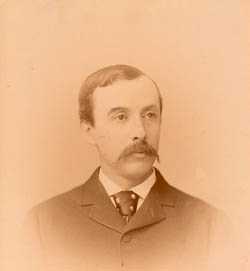
|
| Robert Adams Jr. |
The duel between J. William White, M.D and Robert Adams, Jr. stands as the last-known (April 10, 1880) duel in Philadelphia. The duel was actually fought in the "wedge" of 800 acres of disputed land that had resulted from faulty calculation of the original borders of Maryland, Delaware and Pennsylvania, thus establishing a convenient patch of lawlessness suitable for prizefighting, duels, and whatnot during the long period while lawsuits failed to resolve the geographical matters. Doctor White was much the more flamboyant of the two, so this duel is mostly attached to his name, but Adams seems to have been a person of some consequence, as well.
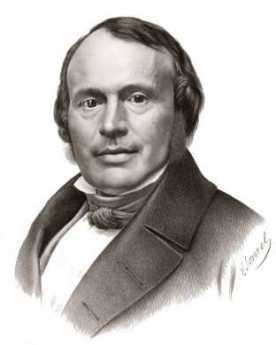
|
| Louis Agassiz |
The sketchy information available about Adams (which readers of this website are urged to supplement) states that he was a member of expeditions exploring Yellowstone Park at roughly the time when young White was a member of a famous expedition on the ship Hassler exploring the coast of South America with Louis Agassiz. Adams seems to have become a serious politician, acting as a Pennsylvania state legislator for a while, then Ambassador to Brazil for a couple of years, then a United States Congressman representing Pennsylvania's 2nd District. While a sitting congressman, he is said to have committed suicide because of financial losses due to speculation. Just what it was that made Adams and White such bitter enemies has long been unclearly wrapped in fanciful speculation.
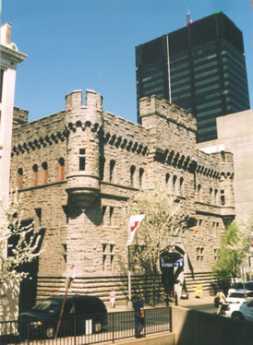
|
| Armory on 23rd Street |
A few years ago, the City Troop was off to Kosovo, leaving the Armory on 23rd Stree quiet enough for Captain Dennis Boylan to poke around in the archives. Here he discovered a pamphlet entitled Frock Coat, Pistols and Champagne which described the events with satiric cartoons, quotations from unsympathetic newspapers, and very likely a certain amount of disinformation. The suggestion is implied that the Troop had indeed declined at that time into a drinking club for useless aristocrats, but the reaction to this public uproar created a determination to restore the Troop to its former serious military and patriotic place, which it has enjoyed ever since. Although it may have been true for a period after the Civil War that the Troop was in decline, its performance before and during the Revolutionary War, and since the 1880 duel, has been one of a serious concern about the duties of privileged families, to lead the way in the sacrifices expected of public leadership.
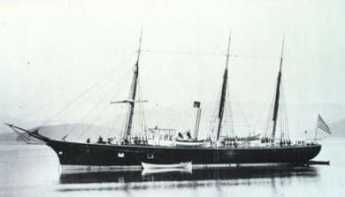
|
| ship Hassler |
As told by Captain Boylan, the lore of the subject suggests that Adams and White had disliked each other for a long time. There was friction about participating in the dedication of the Bunker Hill Monument in Boston, having something to do with who was to be on the right side of the governor of Massachusetts. There was further friction, not well defined, when the Troop was sent to Altoona to bring order to a labor dispute. And there is the question of a doctor wearing the Blue uniform of the Troop. The troop physician had always worn civilian clothes, but White was "ordered" to wear the uniform and it rankled Adams. Since White had been taught boxing by a prison inmate patient at Philadelphia General Hospital and is famous for his involvement in football and other contact sports, it seems likely there were some associated provocations left unrecorded. In any event, when Bill White died, his will left $5000 to the Troop to promote annual remembrance that he was the first troop physician to be ordered to wear the uniform. He left a similar amount to the Franklin Inn for an annual dinner in his name, so you kind of get the idea that he thought a lot of himself. Both men remained members of the troop for some years after the duel, so probably there was a reason to express continuing unworthy opinions of a comrade, in code.
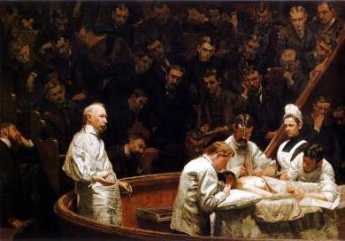
|
| The Agnew Clinic |
There's general agreement that White shot his pistol into the air, while Adams took careful aim -- and missed. In the view of soldiers, therefore, it is clearly true that White comes off looking the better of the two, and for two different reasons. White is the surgeon actually doing the cutting in Thomas Eakins" famous painting of The Agnew Clinic, was a friend of Henry James and Theodore Roosevelt, and became a Trustee of the University of Pennsylvania. But Adams was obviously a person of parts with a contingent of loyal supporters, and probably had an interesting story in his later years. If there is a moral to all this, it is likely to be that fame consists of a large degree of working hard to achieve it. Pick the right painter to do your picture, ingratiate yourself with famous people, and leave some money to institutions with a vigorous development office.
The unknown author of Frock Coat, Pistols, and Champaigne reaches a different conclusion. "Philadelphia, like old Rome, was not without its flock of geese."
Originally published: Friday, April 25, 2008; most-recently modified: Tuesday, June 04, 2019